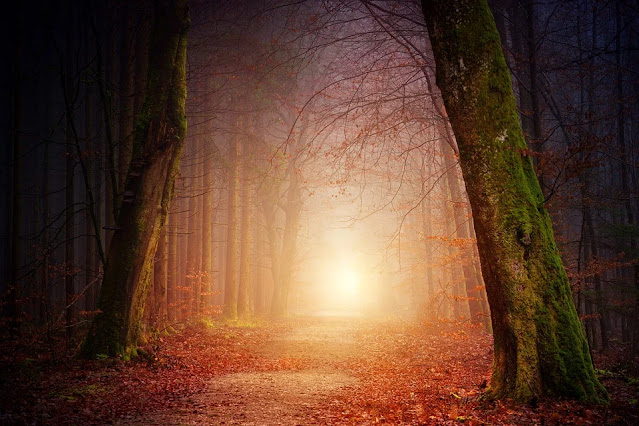When The Sun Stops Shining
The sun shines from the sky for us every day, but it has not always been this way. Throughout history, there have been curious cases of solar obscurations.
Image 1: Throughout history, there have been several mysterious episodes of solar darkening.
These events have been recorded in history, the first mention of such a phenomenon seems to be in the year B, C. 44, historical records say that the sun was paler than usual for a whole year, and gave less heat, the air it was still cold and misty.
However, recent research suggests that brutal volcanic eruptions in Alaska may have caused the darkening. Consequently may have helped the collapse of the Ancient Roman Republic. They're basing their study on old volcanic ash, also known as tephra, found in ice cores taken from the Arctic.
The eruption of 43 BC from Mount Okmok (Alaska); is an event that caused one of the coldest Mediterranean summers and the fall of the Roman Republic.
Image 2: Volcanic explosions are the main reason for long-term darkening.
The bible also narrates the solar darkening with the death of Jesus. From the 6th hour, there occurred darkness over all the land until the 9th hour, also the occurrence of an earthquake.
After the great Nicomedia earthquake, an ancient Greek city, there was darkness for two hours on August 22, AD 358.
Two years later, in the year 360 AD, it happens from early morn till noon in all the eastern provinces of the Roman Empire. The duration of darkness is very unusual for an eclipse.
The description applies to a total solar eclipse, but neither the eclipse of March 4, 360 nor that of AD 358 would be visible in those parts.
In 409 AD, the darkness was such that stars were visible during the day. In 536, the reports indicate that the sun has darkened for a year and two months. Reports exist about extreme weather, in events of 535–536, probably caused by volcanic explosions.
Image 3: Eclipses can be diverse and dark enough to shine the stars of the day.
In the year 626 AD, records from the Byzantine Empire indicate that the sun became dark, and its darkness lasted for eighteen months. Each day it shone for about four hours, and still, this light was only a feeble shadow. The fruits did not ripen, and the wine tasted like sour grapes. However, whose explanation is also unspecified volcanoes.
Bar Hebraeus records a nine-month darkening of the sun at around 628, while the Annals of Ulster record the year 625 as simply "A dark year." Both entries may refer to a large volcanic eruption or a series of volcanic eruptions in unknown locations from the years 620-625.
Schnurrer records that in 733, the sun darkened alarmingly on August 19. The Saracens overcome the Pyrenees due to their defeat at Tours a year after the occasion. Explanations seem to indicate that It is an annular eclipse; however, there are discrepancies in the reported dates; since the eclipse date is on the morning of August 14.
In 934, the sun was darkening for two months in Portugal; however, two catastrophic fissure eruptions originated in the Eastern Volcanic Zone of Iceland, known as Eldgjá eruption (934–940 CE) are reported.
Image 4: An annular eclipse, a mystery to the inhabitants of the past (Image by NASA).
On the last day of February 1206, according to a Spanish writer, there was complete darkness for six hours; the dark became so intense that the stars appeared in the sky at the ninth hour in Spain. In 1241 the sun was so dark; that the stars were in the sky at three p.m; in Vienna.
Subsequently, there have been many similar cases. However, the duration has been short, and their description fits perfectly with solar eclipses.
On May 19, 1780, a dark day occurred in New England, an unusual darkening of the daytime sky over the New England states and parts of Canada. The principal cause of the event may have occurred due to a combination of wildfire smoke, thick fog, and a layer of clouds. The darkness was so complete that the people lighted candles after midday. It did not disperse until the middle of the next night.
According to Harvard University Professor Samuel Williams, the darkness was seen as far north as Portland, Maine, and spread south into New Jersey. The sun's darkening did not occur in Pennsylvania. It is as if the night had fallen at 2:00 p.m. in Ipswich, Massachusetts. A witness reported that the atmosphere had a strong sooty odor and that the rainwater had a light film made up of burnt leaf particles and ash. Contemporary reports also indicated that ash and ash fell in parts of New Hampshire to a depth of six inches (15 cm).
Image 5: Pollution, fog, smoke, and other phenomena can temporarily obstruct the sun.
Throughout history, there have been several occasions of dark days and periods of darkness, almost all of which seem to be associated with environmental events such as volcanic explosions, eclipses, or pollution. However, they have aroused great curiosity, fear, and misunderstanding in humanity for a long time.
References
- J. Ellard Gore.Astronomical Curiosities. Royal Astronomical Society. Link https://www.gutenberg.org/files/39263/39263-h/39263-h.htm.
- HIND, J. Historical Sun-Darkenings. Nature 20, 189 (1879). https://doi.org/10.1038/020189a0.
- Brill. Paul Farquharson. Byzantium, Planet Earth, and the Solar System. Chapter, Pages: 263–269. DOI: https://doi.org/10.1163/9789004344709_023.
- The Irish Sun. Charlotte Edwards. All blown-up Brutal volcanic eruptions in Alaska may have helped the collapse of the Ancient Roman Republic. 11:07, 23 Jun 2020. Link https://www.thesun.ie/tech/5573271/volcano-eruption-roman-republic-fall/.
- Brugnatelli, Vermondo & Tibaldi, Alessandro. (2020). Effects in North Africa of the 934–940 CE Eldgjá and 1783–1784 CE Laki eruptions (Iceland) revealed by previously unrecognized written sources. Bulletin of Volcanology. 82. 73. 10.1007/s00445-020-01409-0.





Comments
Post a Comment